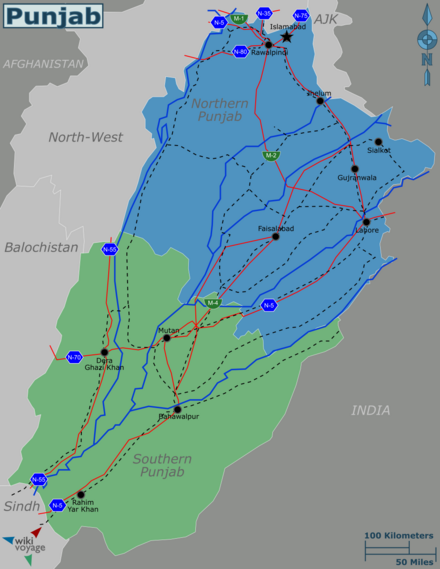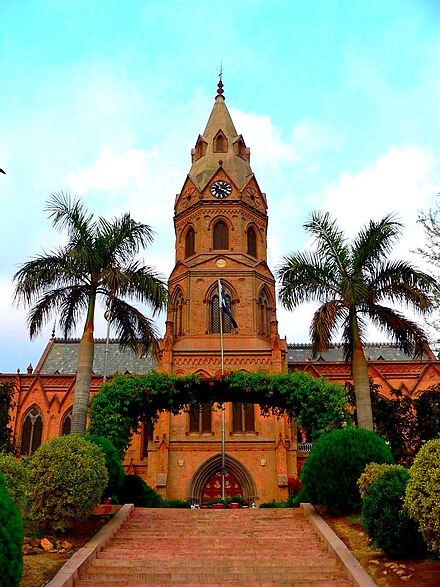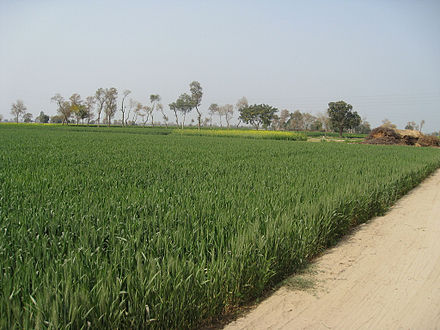Punjab (Pakistan) - province of Pakistan
During the partition, Punjab was divided into two separate provinces, one in Pakistan and one in India. This article covers the Pakistani state of Punjab.<br/>For the Indian province, see Punjab (India). For a general background on the pre-partition region, see Punjab.
Punjab (Punjabi/Urdu: پنجاب) is one of the four provinces of Pakistan, and home to over half the country's population. It is the second largest province in area after Balochistan, and is the most developed and prosperous province. It is the only province that touches every other province of Pakistan.
Regions

Northern Punjab (Islamabad, Rawalpindi, Lahore)
Most visited part of Punjab. Location of the capital territory Islamabad and an exotic popular hill station. Contains the Pakistan's second largest and important historical and cultural centre of the country and Sikh gurdwara built in the 19th century, a popular pilgrimage site for Sikhs from all over the world.
Southern Punjab (Multan, Bahawalpur, Dera Ghazi Khan, Rahim Yar Khan)
Southern part is most famous for its mangoes, tombs and beautiful mosques and encompasses some part of Thar Desert.
Cities

- Islamabad — the capital of Pakistan
- Lahore — the provincial capital, and Pakistan's cultural capital
- Bahawalpur — home to one of the few natural safari parks in Pakistan, Lal Suhanra National Park
- Faisalabad — a textile hub of Pakistan
- Nankana Sahib- Holy place of Sikhism
- Multan — a must stop for tourists, most famous for its wonderful mangoes, friendly people and pottery, also lots of tombs and beautiful mosques
- Rawalpindi — military headquarters
- Sargodha — home of the main Pakistan Air Force base
- Sialkot — famous for its sports and leather industry


Other destinations
- Khewra Salt Mine – the world's second largest salt mine & a tourist complex
- Rohtas Fort
- Cholistan desert
- Nur Mahal in Bahawalpur
- Harappa – Indus Valley Civilization
- Taxila – Gandhara civilization
- Takht-i-Bahi – Buddhist monastery
- Hasanabdal – Sikh holy site
- Nankana Sahib – Sikh holy site
Understand
The name Punjab was introduced by the Mughals in the 17th century CE and is a combination of the Persian words panj (five) and āb (water), thus the (land of) five rivers.
During the partition, Punjab was divided along religious lines. Consequently, the western portion became a part of Pakistan, and the remainder became a part of India.
Punjab is Pakistan's second largest province, and the country's most industrialised province. It borders all of the provinces in Pakistan, and half the population of Pakistan lives here, making it one of the most populous subdivisions in the world.
Strongly influenced by Sufism, the state is also home to numerous holy Hindu and Sikh sites, some of which (e.g. Katasraj Temple) feature prominently in mythology. Guru Nanak, the founder of Sikhism, was born in Nankana Sahib, a small town near the capital city, Lahore. Several important UNESCO world heritage sites are located here.
Virtually all residents of the province are Muslim, although there is a large group of Christians. Many of the country's Christians live here. Other religious minorities include Hindus, Sikhs, and Ahmadiyyas.
Talk
The official language of the province is Punjabi and is a first language to most people. The variant of Punjabi here uses a modified version of the Perso-Arabic script (known as Shahmukhi). If you know how to read and write Persian and/or Urdu, familiarising yourself with Shahmukhi should be a cakewalk.
Although Punjabi is the official language, some people fear that Punjabi is gradually becoming obsolete due to the dominance of Urdu and English. As in any other place, making an attempt to learn a few words, or speak the language, will go a long way and will most certainly endear you to the locals.
As in most places throughout Pakistan, Urdu and English are understood in urban areas. You should not have any problems getting by using only English.
In the south, Seraiki is the main language.
Get in
Lahore and Islamabad have direct flights to numerous international destinations across Asia, the Greater Middle East and Europe. There are buses and trains between Delhi and Lahore. From Kashgar, China, you can travel by road via the Karakoram Highway up to Gilgit for about US$50 and from Gilgit there are direct buses to Islamabad for about US$5 but 17 hours of journey on harrowingly winding roads.
By plane
Lahore, Islamabad and Sialkot are the main gateways to Outer Punjab by air. However, there are 134 airfields in Pakistan.
- Allama Iqbal International Airport in Lahore has a terminal for international arrivals and departures. Many airlines operate to the airport including Emirates, Etihad Airways, Mahan Air, Qatar Airways, Gulf Air, Singapore Airlines, Pakistan International (PIA), Saudi Arabian Airlines, Thai Airways, Kuwait Airways, Uzbekistan Airways and over four private airlines from Pakistan.
- Benazir Bhutto International Airport There are many airlines operating into Islamabad including many of the above with Ariana Afghan Airlines, British Airways and China Southern Airlines. The only problem is that the airport is also used by Government officials and for arrivals from foreign diplomats so the airport may shut down as security is increased so flights are delayed.
- New Islamabad International Airport - opened May 2018.
By train
Punjab has train links with its neighbour the Republic of India to the east. The Samjhauta Express is the more common, running on Tuesdays and Fridays between Delhi and Lahore via the Attari/Wagah border crossing. After terrorist attacks on the train, which caused many a casualty and strained relationships between the two neighbors, it is strongly advised that you take taxis or buses to and from the border instead.
By car
From ancient times people have been travelling through Punjab using the Grand Trunk Road that runs through Pakistan and into India. It is a rewarding but time-consuming way to see this part of the world. New highways have been developed and the country is due for an expansion in its highway network. A world-class motorway connects the cities of Lahore, Islamabad and Faisalabad
Punjab is connected to China through the Karakoram Highway, a modern feat of engineering that traverses a remarkably scenic route through the Karakoram and Himalayan mountains. Which is about to be expanded from current 10-m wide to 30-m because of the increase in trade traffic due to Gwadar port opening.
By bus
From India: While there is international service running to Lahore from Delhi it is just as fast, much more flexible, and much cheaper to take the journey by stringing together local transport and crossing the Wagah border on foot.
From China: While there is international service running to Islamabad from Kashgar it is just as fast, much more flexible, and much cheaper to take the journey by stringing together local transport and crossing the border on foot.
Get around
 The Grand Trunk Road runs through Punjab, but it's a slow road. New highways have been developed and the country is due for an expansion in its highway network. A world-class motorway connects the cities of Lahore, Islamabad and Faisalabad.
The Grand Trunk Road runs through Punjab, but it's a slow road. New highways have been developed and the country is due for an expansion in its highway network. A world-class motorway connects the cities of Lahore, Islamabad and Faisalabad.
See
The province is home to many well-known historical sites including the Shalimar Gardens, the Badshahi Mosque, and the ruins of the ancient city of Harrapa. The Anarkali Market and Jahangir's Tomb are prominent in the city of Lahore as is the Lahore Museum, while the ancient city of Taxila in the northwest was once a major centre of Buddhism. Many important Sikh shrines are in the Pakistani portion of Punjab, including the birthplace of the first Guru: Guru Nanak (born at Nankana Sahib), you can visit the Wagah border parade it is called the beating retreat ceremony between the IBSF and the Pakistani Rangers. There is also the largest salt mine in Asia situated the Khewra Salt Mines.
Do
Eat
 What to eat in Punjab, Pakistan - Popular Punjabi Cuisine:
What to eat in Punjab, Pakistan - Popular Punjabi Cuisine:
Punjab is one of Pakistan's most cosmopolitan and culturally rich provinces, and it is well known for its delectable and varied food. You should sample some of the popular meals in Punjab, Pakistan, including:
-
Makki ki roti and Sarson ka saag - This is a staple dish made from corn flour bread and a thick, flavorful mustard greens sauce.
-
Chana Masala - Chickpeas cooked in a rich, flavorful sauce made with spices, tomato, and onion.
-
Butter chicken - A popular North Indian dish made with tender, juicy chicken cooked in a creamy tomato-based sauce.
-
Tandoori chicken - Chicken marinated in yogurt and spices, then grilled in a traditional clay oven called a tandoor.
-
Amritsari kulcha - A type of Indian bread that is stuffed with vegetables or paneer (cottage cheese) and cooked in a tandoor
-
Biryani - A fragrant and flavorful rice dish cooked with spices, meat, and vegetables.
-
Aloo Gobi - A dish made from potatoes and cauliflower cooked in a spicy tomato-based sauce.
-
Lahori fried fish - Fried fish seasoned with spices and served with tangy chutney, a staple food in Lahore.
These are only a handful of the mouthwatering foods you may sample in Punjab, Pakistan. Enjoy your gastronomic exploration!
Drink
- Tea (or Chai as it is referred to in Pakistan) is popular throughout the country.
- Both black and green tea (Sabz chai or qahvah) are common and are traditionally drunk with cardamom and lots of sugar. Lemon is optional but recommended with green tea.
- Kashmiri chai is a milky tea with almonds and nuts added to give additional flavour. This tea is very popular during weddings and in the cold season.
- Coffee is also available in all major cities.
In the warmer southern region, sweet drinks are readily available throughout the day. Look for street vendors that have fruits (real or decorations) hanging from their roofs. Also, some milk/yogurt shops serve lassi. Ask for meethi lassi for a sweet yogurt drink and you can also get a salty lassi which tastes good if you are having "bhindi" in food or some other rich dish. There is also a sweet drink called Mango Lassi which is very rich and thick, made with yogurt, mango pulp, and pieces of mango.
Drink sealed bottled water, not the water from local taps. Water from local taps will be infected and it is highly likely you will end up ill.
Stay safe
The people of Punjab are hospitable. They tend to welcome any foreigner very warmly.
For your own safety it is strongly recommended not to attend any rallies, protests or religious gatherings. Otherwise, Punjab is generally safe but crime exists in big cities.
In an emergency, call police by 15 from any landline phone. To get an ambulance, dial 115 from any landline or mobile phone. If you find yourself in serious trouble and need any type of emergency rescue or help, dial 1122.
